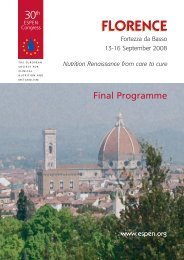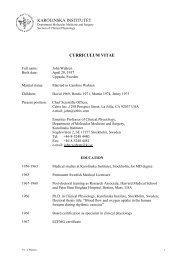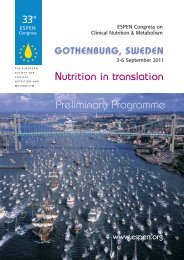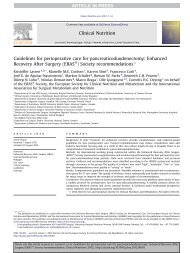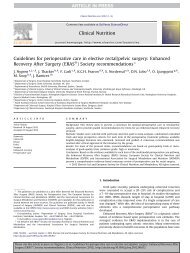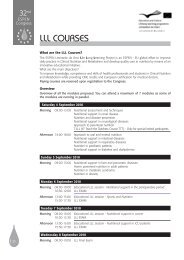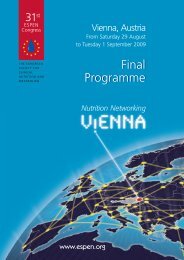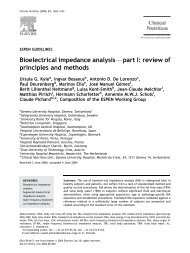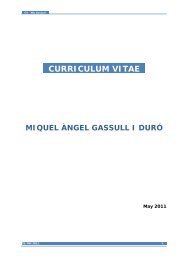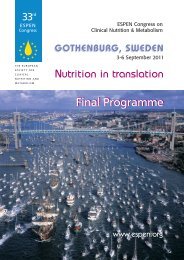ESPEN Guidelines on Parenteral Nutrition: Hepatology
ESPEN Guidelines on Parenteral Nutrition: Hepatology
ESPEN Guidelines on Parenteral Nutrition: Hepatology
You also want an ePaper? Increase the reach of your titles
YUMPU automatically turns print PDFs into web optimized ePapers that Google loves.
440<br />
administrati<strong>on</strong> had a significant, positive effect <strong>on</strong> the course of HE,<br />
but not <strong>on</strong> survival. 93 Recently, it has been dem<strong>on</strong>strated that, due<br />
to the absence of isoleucine from haemoglobin, blood is a protein<br />
source of low biologic value leading to BCAA antag<strong>on</strong>ism after<br />
upper gastrointestinal haemorrhage. This antag<strong>on</strong>ism leads to<br />
hyperamm<strong>on</strong>aemia but HE could be overcome by the infusi<strong>on</strong> of<br />
just isoleucine. 94 Isoleucine soluti<strong>on</strong>s for i.v. infusi<strong>on</strong>s, however, are<br />
not commercially available. Special hepatic formula amino acid<br />
soluti<strong>on</strong>s (c.f. above) c<strong>on</strong>tain high amounts of isoleucine and of the<br />
other BCAAs, leucine and valine.<br />
In cirrhotic patients undergoing liver resecti<strong>on</strong>, oesophageal<br />
transecti<strong>on</strong> and splenectomy or splenorenal shunt, the rate of HE<br />
was not increased when a c<strong>on</strong>venti<strong>on</strong>al amino acid soluti<strong>on</strong><br />
(50 g d 1 ) was used for postoperative PN instead of a BCAAenriched<br />
amino acid soluti<strong>on</strong> (40 g d 1 ). 42 Moreover, no difference<br />
was observed between a standard and a BCAA-enriched amino acid<br />
soluti<strong>on</strong> after liver transplantati<strong>on</strong>. 43<br />
After transplantati<strong>on</strong> there is a c<strong>on</strong>siderable nitrogen loss and<br />
patients remain in negative nitrogen balance for up to 28 days 59,95<br />
necessitating an increase in the provisi<strong>on</strong> of protein or amino acids.<br />
Protein or amino acid intakes of 1.0–1.5 g kg 1 d 1 have been<br />
reported. 30,43 The determinati<strong>on</strong> of postoperative urea nitrogen<br />
excreti<strong>on</strong> has proved helpful in the assessment of individual<br />
nitrogen requirements.<br />
Animal data indicate that the balanced nutriti<strong>on</strong> of a brain dead<br />
liver d<strong>on</strong>or, using moderate amounts of carbohydrate, lipid (l<strong>on</strong>gchain<br />
fatty acids and possibly fish oil) and amino acids, is associated<br />
with improved functi<strong>on</strong> of the transplanted organ. 96 The value of<br />
d<strong>on</strong>or or organ c<strong>on</strong>diti<strong>on</strong>ing which aims to reduce ischaemia/<br />
reperfusi<strong>on</strong> damage in man by provisi<strong>on</strong> of high doses of arginine<br />
or glutamine is unclear.<br />
2.5. Water, electrolytes, vitamins, trace elements<br />
Water, electrolytes, water- and fat-soluble vitamins and trace<br />
elements should be given daily in order to cover daily requirements<br />
(C).<br />
Comments: body compositi<strong>on</strong> of cirrhotics is altered<br />
profoundly and characterised by protein depleti<strong>on</strong> and accumulati<strong>on</strong><br />
of total body water even in Child-Pugh class A patients. 97,98<br />
This goes hand-in-hand with salt retenti<strong>on</strong>, which therefore does<br />
not usually lead to hypernatraemia. On the c<strong>on</strong>trary, depleti<strong>on</strong> of<br />
potassium, magnesium, phosphate and other intracellular minerals<br />
are frequent. In an early study comparing PN vs. oral diet in<br />
cirrhotic patients with ascites, the resp<strong>on</strong>se to diuretics was poorer<br />
in those patients receiving PN. 12<br />
No recommendati<strong>on</strong> <strong>on</strong> the requirement of micr<strong>on</strong>utrients can<br />
be made <strong>on</strong> the basis of c<strong>on</strong>trolled studies. As in other c<strong>on</strong>diti<strong>on</strong>s,<br />
the administrati<strong>on</strong> of micr<strong>on</strong>utrients has no proven therapeutic<br />
effect apart from the preventi<strong>on</strong> or correcti<strong>on</strong> of deficiency states.<br />
Supplementing zinc and vitamin A may indirectly improve food<br />
intake and nutriti<strong>on</strong>al state by improving dysgeusia. 99,100 Zinc and<br />
selenium deficiency have been observed in alcoholic and n<strong>on</strong>alcoholic<br />
liver disease. 101–104 An impressive associati<strong>on</strong> between<br />
HE and zinc deficiency has been described in case reports. 105,106<br />
C<strong>on</strong>trolled trials of oral zinc supplementati<strong>on</strong>, however, have failed<br />
to prove a therapeutic effect <strong>on</strong> HE. 107–109 Urea producti<strong>on</strong> capacity<br />
increased after oral zinc applicati<strong>on</strong> when previously subnormal<br />
plasma levels were normalised. 110<br />
A deficiency in water soluble vitamins, mainly group B vitamins,<br />
is comm<strong>on</strong> in cirrhosis, especially that of alcoholic origin. 111,112<br />
Deficiency in fat-soluble vitamins has been observed in cholestasisrelated<br />
steatorrhoea, bile salt deficiency, and in alcoholics. 113,114<br />
Supplementati<strong>on</strong> with calcium and vitamin D is recommended for<br />
M. Plauth et al. / Clinical Nutriti<strong>on</strong> 28 (2009) 436–444<br />
patients with osteopenia, although this did not result in any<br />
improvement in b<strong>on</strong>e density in patients with primary biliary<br />
cirrhosis; oestrogen substituti<strong>on</strong> proved to be much more effective<br />
in female patients. 113,115<br />
In a pragmatic approach, liberal supplementati<strong>on</strong> is recommended<br />
in the first two weeks of nutriti<strong>on</strong>al support, because the<br />
laboratory diagnosis of a specific trace element or vitamin deficiency<br />
may be more costly, and would delay provisi<strong>on</strong>. Due to the<br />
high prevalence of malnutriti<strong>on</strong> in this patient group cirrhotic<br />
patients are in danger of developing refeeding syndrome and<br />
additi<strong>on</strong>al phosphate, potassium and magnesium may be required.<br />
In transplanted patients the often pre-existing chr<strong>on</strong>ic diluti<strong>on</strong>al<br />
hyp<strong>on</strong>atraemia should be corrected carefully in order to avoid p<strong>on</strong>tine<br />
myelinolysis. 116 Magnesium levels need to be m<strong>on</strong>itored in order to<br />
detect and treat ciclosporin or tacrolimus induced hypomagnesaemia.<br />
117 Postoperative hypophosphataemia and its possible<br />
relati<strong>on</strong> to PN following right hemihepatectomy in living d<strong>on</strong>ors has<br />
been reported by some but not all study groups. 118–120<br />
3. Acute liver failure<br />
Preliminary remarks: due to the substantial loss of liver cell<br />
functi<strong>on</strong>, acute liver failure (LF) is a serious c<strong>on</strong>diti<strong>on</strong> characterised<br />
by profound metabolic dysfuncti<strong>on</strong> and is almost invariably<br />
complicated by multiple organ failure. Depending <strong>on</strong> the interval<br />
between the <strong>on</strong>set of jaundice and that of HE, hyperacute (interval<br />
< 8 days), acute (interval < 29 days) and subacute liver failure<br />
(interval 29–72 days) are distinguished. 121 There is a more favourable<br />
prognosis in hyperacute than in acute or subacute LF.<br />
Despite the clinical significance of metabolic derangements like<br />
hypoglycaemia or hyperamm<strong>on</strong>aemia and encephalopathy, there<br />
are <strong>on</strong>ly limited data from animal experiments or descriptive<br />
physiology data and no data from clinical trials, <strong>on</strong> which to base<br />
a rati<strong>on</strong>al metabolic interventi<strong>on</strong> like nutriti<strong>on</strong>al therapy.<br />
3.1. Indicati<strong>on</strong> and timing of PN<br />
As in other critically ill patients artificial nutriti<strong>on</strong> in acute LF<br />
is indicated when the patient is c<strong>on</strong>sidered unlikely to resume<br />
normal oral nutriti<strong>on</strong> within the next 5–7 days irrespective of<br />
current nutriti<strong>on</strong>al state. PN is helpful in patients who cannot be<br />
fed adequately by enteral nutriti<strong>on</strong>.<br />
Comments: in the treatment of acute LF, measures to stabilize<br />
the metabolism and vital functi<strong>on</strong>s and the treatment of brain<br />
oedema are of utmost importance. In this c<strong>on</strong>diti<strong>on</strong> nutriti<strong>on</strong>al<br />
therapy has two objectives:<br />
(1) ensuring the adequate provisi<strong>on</strong> of energy, especially assuring<br />
euglycaemia by giving glucose, lipid, vitamins and trace<br />
elements; and<br />
(2) ensuring optimal rates of protein synthesis by providing an<br />
adequate intake of protein or amino acids, respectively.<br />
3.2. Energy intake<br />
In acute liver failure resting energy expenditure is increased<br />
1.2- to 1.3-fold compared to healthy individuals. Whenever<br />
possible, the individual’s energy requirement should be measured<br />
by use of indirect calorimetry (C).<br />
Comments: surprisingly few liver units seem to measure or<br />
even calculate the energy expenditure of patients with acute liver<br />
failure 122 despite the well-known fact that hepatic energy



